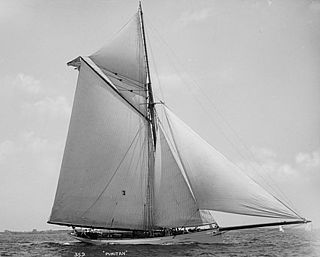
The Puritan was a 19th-century racing yacht and the 1885 America's Cup defender of the international sailing trophy.

USS Liberty III (SP-1229), sometimes written Liberty # 3, and also referred to during her naval career as Liberty and as Pilot Boat Liberty, No. 3, was a United States Navy patrol vessel in commission from 1917 to 1919. The Liberty was a pilot boat from 1896-1917. She was a replacement for the pilot boat D. J. Lawlor. After World War I, the Liberty returned to pilot service until 1934 when she was purchased as a yacht.

The Richard K. Fox, first named Lillie, was a 19th-century pilot boat built in 1876 for Boston Pilots. She was designed by model by Dennison J. Lawlor. She was one of the most graceful and attractive of the Boston pilot-boats and represented a trend toward deep-bodied boats. She was later sold to the New York pilots and renamed Richard K. Fox in honor of the famous sportsman and publisher of the Police Gazette. In the age of steam, she was sold in 1896 to the Marine Hospital Service.

The Sylph was a 19th-century pilot boat first built in 1834, by Whitmore & Holbrook for John Perkins Cushing as a Boston yacht and pilot-boat for merchant and ship owner Robert Bennet Forbes. She won the first recorded American yacht race in 1835. She was a pilot boat in the Boston Harbor in 1836 and 1837 and sold to the New York and Sandy Hook Pilots in October 1837. She was lost in winter of 1857 with all hands during a blizzard off Barnegat, New Jersey. The second Sylph was built in 1865 from a half-model by Dennison J. Lawlor. The third Sylph was built in 1878 at North Weymouth, Massachusetts for Boston Pilots. She was sold out of service in 1901, after 23 years of Boston pilot service.

James H. Reid, was a 19th-century American Maritime pilot. He is best known for being the dean of the Boston pilots, serving for 55 years. He was captain of the famous yacht America for 17 years when she was owned by Benjamin F. Butler. In 1897, he built a new America, named after the America's Cup defender.
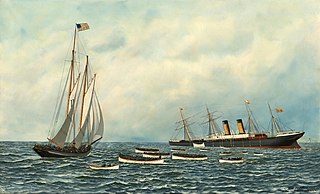
The Phantom was a 19th-century Sandy Hook pilot boat built in 1867 from the designs by Dennison J. Lawlor. The schooner was considered a model for her type with a reputation for being very fast. She helped rescue the passengers on the steamship SS Oregon when it sank in 1886. She was one of the pilot-boats that was lost in the Great Blizzard of 1888. The Phantom was replaced by the pilot-boat William H. Bateman.

The D. J. Lawlor was a 19th-century Boston pilot boat built in 1881 at North Weymouth, Massachusetts. The schooner was considered the largest for her type, noted for her seaworthiness and heavy weather performance. She was named after the prominent Boston shipbuilder Dennison J. Lawlor. She was struck by a fishing schooner Horace B. Parker, in 1895, and was replaced by the pilot-boat Liberty in 1896.

Abel F. Hayden, was a 19th-century American Maritime pilot. He was one of the oldest Boston pilots, serving for over thirty years. He helped bring in the USS San Jacinto, into the Boston Harbor in 1861. Hayden was owner of the pilot-boat D. J. Lawlor, that was struck by a fishing schooner Horace B. Parker, in 1895.

Thomas Francis McManus was a fish merchant who became a naval architect, responsible for introducing the shortened bowsprit and long stern overhang to give speed to his vessels. He was well known for revolutionizing the Gloucester fishing schooner. He made the fastest vessels of their type in the world and was honored on two continents for his skill as a naval architect. He became known as the "Father of the Fishermen's Races." 500 fishing schooners used his designs to improve speed. He was a friend of Sir Thomas Lipton and President Theodore Roosevelt.
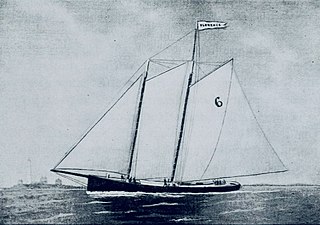
Florence was a 19th-century Boston pilot boat built in 1867 from a model by Dennison J. Lawlor for William C. Fowler. The vessel had a reputation for being fast under sail. She had a long career in the Boston service, skippered by many famous pilots. She was the oldest pilot-boat in the service. In 1897, she was sold to a Portland, Maine group for fishing and yachting excursions. The pilot boat America, No. 1, was launched on April 19, 1897, to replace the Florence.
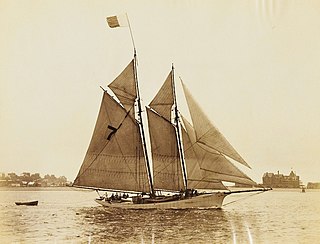
Minerva was a 19th-century Boston pilot boat built in 1896 by Ambrose A. Martin of East Boston, Massachusetts. She was owned by Franklin B. Wellock who was a Boston pilot for more than 55 years. The pilot-boat was named for his daughter, Minerva Hill. She was sold to Plymouth parties in 1901 to be used as a fishing vessel.

The Edwin Forrest was a 19th-century pilot boat built in 1855 by Jacob A. Westervelt's Sons & Co., for a group of New York pilots. She was designed by Dennison J. Lawlor, for Pilot Captain John Low. The Edwin Forrest was named in honor of the American actor Edwin Forrest. A second Edwin Forrest was built for Boston pilots in 1865 to replace the New York Edwin Forrest, No. 14, that was lost in 1862. She attained celebrity for her speed and stability. The Edwin Forrest was sold to Pensacola, Florida parties in 1882 and replaced by the George H. Warren.

The Adams was a 19th-century Boston pilot boat, built in 1888 by Moses Adams at Essex, Massachusetts for Captain John H. Jeffries. She was named for Melvin O. Adams, an American attorney and railroad executive. Her design was by yacht designer Edward Burgess, known for his America's Cup defenders. In 1901, she was one of only five pilot-boats left in the Boston fleet. In 1912, she was sold to haul gravel to Boston, then sold again where she landed in the Portuguese immigrant trade. She was sunk by enemy action during World War I.

The Varuna was a 19th-century Boston pilot boat, built by Montgomery & Howard at Chelsea, Massachusetts in 1890, for a group of Boston pilots. She was designed by yacht designer Edward Burgess, known for his America's Cup defenders. She was the first centerboard pilot-boat in operation in the Massachusetts Bay. The Varuna went out of service in 1912 because of the introduction of steam power into pilot-boats. She was later sold to Stephen Simmons to be used as a trading vessel between ports in the Spanish Main in 1913.
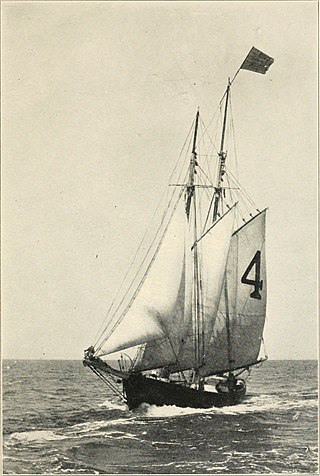
The Trenton was an auxiliary motor pilot boat built in Essex County, Massachusetts for a company of New Jersey Sandy Hook pilots in 1907. She was formerly the fishing schooner Kernwood, designed by Thomas F. McManus of Boston in 1904. As a pilot boat, she spent twenty-five years in pilot service before being placed out of service in 1934.
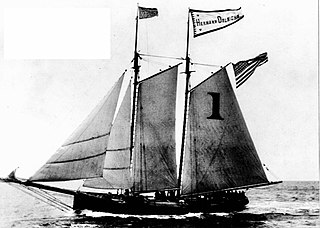
The Hermann Oelrichs was a 19th-century Sandy Hook Pilot boat, built in 1894 by Moses Adams at Essex, Massachusetts for a group of New York Pilots. She helped transport New York City maritime pilots between inbound or outbound ships coming into the New York Harbor. The Herman Oelrichs was said to be the fastest of the New York pilot fleet. She was built to replace the pilot boat Hope, that was wrecked in 1890.

The Friend was a 19th-century pilot boat built by Daniel D. Kelley & Holmes East Boston shipyard in 1848 for Boston pilots. She helped transport Boston maritime pilots between inbound or outbound ships coming into the Boston Harbor. The Friend was one of the last of the low sided, straight sheared schooners built in the 1840s for Boston pilots. The second Boston pilot boat Friend was built in 1887. Her name came from the older Friend that was in the service in the late 1840s. Captain Thomas Cooper sold the Friend to New York pilots in 1893. Cooper replaced the Friend with the pilot-boat Columbia in 1894.
Dennison J. Lawlor, was a 19th-century Canadian-Irish shipbuilder and yacht designer. He apprenticed under shipbuilder Whitmore & Holbrook. Lawlor had his own shipyard, building and designing for 40 years some of the finest yachts, pilot boats, and 150 merchant vessels built from his designs. The most notable were the Hesper, Florence, and D. J. Lawlor. Lawlor died in Chelsea, Massachusetts in 1892.
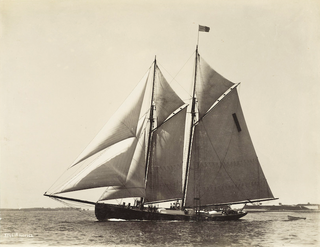
The America, No. 1 was a 19th-century American pilot boat built in 1897 for Captain James H. Reid Sr. of Boston and designed by Boston designer Thomas F. McManus. The Boston America did not resemble her famous namesake, yacht America, rather she was designed with a fishing schooner "Indian header" bow. After serving 21 years in the Boston Pilots' Association, the America was sold to David W. Simpson of Boston in 1918.

Moses Adams, was a 19th-century prominent Essex shipbuilder. He had his own shipyard and built eighty-five schooners and pilot boats. Adams died in Essex, Massachusetts in 1894.























